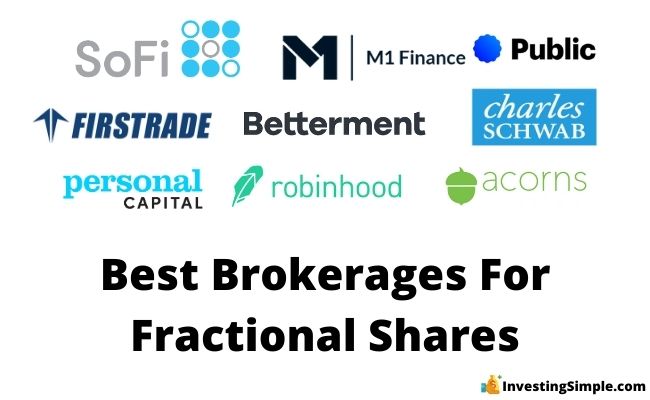





If you’re a small or medium-sized investor, you’ll want to know if a brokerage offers fractional shares before investing any money with them.
Fractional shares are the great equalizer when it comes to investing. That’s because they enable an investor with a small amount of money to spread their funds among dozens or even hundreds of individual securities with just a few dollars.
Fractional shares are a relatively recent innovation that enables you to purchase a portion of a high-priced stock (or fund) rather than needing to buy a whole share. For example, you can invest just $1 in a $100 stock and own a fraction of one share. This also means you could invest $1 in each of 100 stocks to build a diversified portfolio with just $100.
Fractional shares also extend to ETFs and mutual funds. Many brokers allow investing as little as $1 or $5 in a single share of an ETF, reducing the cash required to achieve diversification. Fractional shares are one reason automated robo-advisors can construct a diversified portfolio across multiple ETFs with only a few dollars. In short, fractional shares ensure that money is no longer a limiting factor when it comes to investing.
Below is our updated list of top brokerages offering fractional shares, with the latest features and minimums:
| Brokerage | Min. Investment | Accounts Offered | Assets Available | Fees | Notable Features |
|---|---|---|---|---|---|
| Robinhood | $1 | Individual, Joint, Traditional & Roth IRAs, Cash | U.S. Stocks, ETFs, Crypto, ADRs | No commissions on U.S. trades (ADRs may incur small fees) | No account minimums, $1 increments, cryptocurrency trading, IRA match |
| M1 Finance | $100 ($500 IRA) | Individual, Joint, Traditional, Roth, Rollover, SEP IRAs, Trusts | Stocks, ETFs | None | Customizable “pies,” automated rebalancing |
| SoFi Invest | $1 | Individual, Joint, Traditional & Roth IRAs | Stocks, ETFs, Options, Crypto (Active); Automated ETF portfolios (Robo) | $0 commission (Active); 0.25% AUM (Automated after $50) | Live advisors, integrated cash management |
| Betterment | $10 | Individual, Joint, Traditional, Roth, Rollover, SEP IRAs, Trusts, Nonprofits | ETF portfolios (stocks & bonds) | 0.25% (Digital); 0.65% Premium ($100k min) | Automated portfolios, tax-loss harvesting |
| Public | $5 | Individual taxable | Stocks, ETFs, U.S. Treasuries & bonds | None | Social investing, mobile-first, chat/email support |
| Acorns | None | Taxable, Traditional & Roth IRAs, Custodial | ETF portfolios (includes stocks, bonds, REITs) | From $3–$12/month (plans) | “Round-Up” micro-investing, free checking |
| Stash | None | Taxable, Traditional & Roth IRAs, Custodial | Individual stocks, ETFs | $3–$9/month (plans) | Automated savings, self-directed investing |
| Fidelity | $1 | Individual, Joint, Traditional, Roth, Rollover, SEP IRAs, Trusts | 7,000+ U.S. Stocks & ETFs (fractional) | None (commissions on stocks/ETFs waived) | Dollar-based trading, extensive research tools |
| Vanguard | $1 | Individual, Joint, Traditional, Roth, Rollover, SEP IRAs, Trusts | Vanguard ETFs (fractional); Vanguard mutual funds | None (on Vanguard ETF trades) | Dollar-based investing ($1 min), auto-dividend reinvestment |
| Interactive Brokers | $1 | Individual, Joint, Traditional & Roth IRAs, Trusts, Institutional | 11,000+ U.S. & European Stocks, ETFs (fractional eligible) | Varies ($0 on IBKR Lite; low fees on IBKR Pro) | Global access, advanced tools, 24/6 support |
Robinhood is a popular commission-free trading platform that made investing accessible for young and new investors. It offers trading in U.S. stocks, ETFs, options, cryptocurrencies, and ADRs (foreign stocks). Robinhood requires no minimum deposit for a standard brokerage account, and you can buy fractional shares in $1 increments. The platform also now offers Traditional and Roth IRAs (with a contribution match up to 3%), joint brokerage accounts, and a cash management account.
Because Robinhood is designed for self-directed investors, it has fewer bells and whistles than some full-service brokers. However, it still provides live phone and in-app chat support (in addition to email), and it continues to expand its features. Robinhood’s commission-free model means you pay no trading fees on U.S. stocks, ETFs, options, or crypto (small fees may apply on ADR trades).
M1 Finance lets you invest in up to 100 individual stocks and ETFs with just $100. It does this through fractional shares. On M1, you create one or more “pies” (portfolios) by selecting individual stocks or ETFs. Each pie can contain up to 100 slices, and M1 automatically manages and rebalances your pies as you add money. This combines the flexibility of self-directed investing with automated portfolio management.
SoFi offers two investing platforms: automated robo-advisor accounts (SoFi Wealth) and self-directed trading accounts (SoFi Active Investing). SoFi Wealth provides automated portfolios of ETFs, while SoFi Active Investing lets you trade individual stocks, ETFs, options, and cryptocurrencies. You only need $1 to open a SoFi Invest account, and fractional shares allow you to buy portions of any stock or ETF. (Note: the robo accounts typically require a $50 minimum deposit.)
SoFi also provides cash management with high-yield checking and linking services, and it gives customers access to live financial advisors for guidance. Combined with no commissions on stock trades, SoFi is an attractive choice for savers and investors who want both digital advice and bank-like services.
Betterment pioneered the use of fractional shares for retail investors. It allows you to invest in a diversified portfolio with just $10, using low-cost ETFs. Betterment offers automated portfolio management and personalized advice at a low annual fee. There are two main plans: Digital (0.25% AUM) and Premium (0.65% AUM, minimum $100,000).
Betterment builds a mix of stock and bond ETFs for you, rebalances periodically, and provides features like tax-loss harvesting (on taxable accounts) and goal-based advice. It also offers a high-interest cash reserve account for cash holdings.
Public is a mobile-first investment app that emphasizes fractional shares and social investing. You can open an account with $0, but need at least $5 to buy any fractional share through the platform. Public offers commission-free trading for U.S. stocks, ETFs, and also provides access to U.S. Treasury and corporate bond funds.
The app includes a social network where you can discuss strategies with other investors. Public does not offer retirement accounts or mutual funds. It is focused solely on individual taxable investing with real-time market access.
Offer valid for U.S. residents 18+ and subject to account approval. See Public.com/disclosures.
Acorns is a micro-investing app that helps you save and invest spare change. It rounds up your everyday purchases to the next dollar and invests the difference in a portfolio of ETFs. This makes it easy to accumulate investment funds gradually. For example, buying an item for $4.25 would round up to $5, investing the $0.75 difference.
Acorns invests your money in diversified ETFs across stocks, bonds, and REITs using fractional shares, and it manages your portfolio automatically. It also offers checking accounts and a debit card as part of its service.
Stash is a micro-savings and investment app that helps you accumulate funds and then invest them. Stash can automatically transfer money from your bank account by analyzing your spending, and you can also set up round-up transfers (like Acorns) to save spare change. Unlike Acorns, with Stash you choose your own stocks or ETFs to buy (the app provides recommendations and themes).
Stash allows fractional share investing in U.S. stocks and ETFs. It supports individual and joint taxable accounts, as well as Traditional and Roth IRAs and custodial accounts for minors.
Fidelity is one of the most robust platforms for fractional share investing. It offers access to over 7,000 U.S. stocks and ETFs that can be purchased in fractional shares. You can start investing with as little as $1 per stock or ETF.
Fidelity Basic Features
How Fidelity Fractional Shares Work
Fidelity’s “Stocks by the Slice” program lets you buy a dollar amount of almost any eligible U.S. stock or ETF. For example, if you have $25 to invest in a share that trades at $100, Fidelity will execute the fractional order for you and allocate 0.25 shares to your account.
Pros
Cons
Overall, Fidelity’s combination of low costs, broad investment options, and robust tools make it an excellent choice for anyone looking to start or expand their fractional investing journey.
Vanguard, a long-standing leader in low-cost investing, now offers dollar-based investing for its ETFs and mutual funds. You can purchase fractional shares of Vanguard ETFs with as little as $1. (However, most Vanguard mutual funds still have their standard initial minimums, typically $1,000 or more.)
Vanguard’s dollar-based investing lets you trade any Vanguard fund in terms of dollars rather than whole shares. You can buy or sell Vanguard ETFs or mutual fund shares in any dollar amount (from $1 upward), which helps avoid having idle cash (“cash drag”) in your account. Dividends and distributions are allocated proportionally, and you can opt to reinvest dividends automatically.
Vanguard remains a top choice for investors focused on long-term growth and low costs, especially those who want to build a diversified portfolio with Vanguard’s own products.
Interactive Brokers (IBKR) is renowned for its global reach and advanced trading tools. It offers fractional share trading for a vast range of securities: thousands of U.S. and international stocks and ETFs (over 11,000 instruments eligible).
IBKR lets you specify either a dollar amount or share quantity when placing an order. For most eligible stocks and ETFs, the platform will fill the fractional portion via an affiliated principal if needed. (You must activate fractional trading in your account settings.) Dividends are paid proportionally to fractional holders. IBKR supports advanced order types and allows dollar-based or share-based investing.
Interactive Brokers is an outstanding choice for investors who want global diversification, advanced tools, and fractional trading across many markets.
When you buy a fractional share, you’re not buying from some pool of leftover stock pieces. Instead, brokerages buy whole shares and allocate fractional portions to investors. This is often done by having the brokerage (or its clearing firm) buy whole shares and internally match the fractional share component to customer orders.
For example, Fidelity explains that whole shares are executed in the open market, and fractional shares are often matched against its clearing firm’s inventory or as a principal trade. As Fidelity notes: "Fidelity Brokerage Services LLC (FBS) uses National Financial Services (NFS) as our clearing firm. FBS acts as your agent, and NFS acts either as principal or in a mixed capacity. Whole shares are executed in the open market, and fractional shares are often matched against NFS’s principal account." Similarly, Interactive Brokers states: "In connection with any fractional share component of a transaction, an IBKR affiliate generally acts as the counterparty and executes the trade as principal or riskless principal." These disclosures highlight that brokerages handle fractional trades internally, which ensures orders can be filled even for tiny share amounts. (Note: fractional positions typically cannot be transferred to another broker – they must be sold first.)
Fractional investing isn’t just for beginners. Its full value comes from several key advantages:
Investors can specify exact dollar amounts instead of calculating share quantities. Want to invest $25 in Google? No math required — just enter $25 and the broker will figure out the fraction of a share to buy.
New AI-driven tools can recommend portfolio allocations based on your risk profile, goals, and market trends — optimizing your portfolio down to the cent using fractional trades.
Fractional shares enable tax-loss harvesting and precise portfolio rebalancing for investors of all income levels, not just the wealthy. Robo-advisors can sell fractional positions to harvest losses without fully selling out of an investment.
Platforms are expanding fractional offerings in niche asset classes. For example, investors can now buy fractional interests in sustainable real estate projects or green infrastructure funds, aligning their portfolios with environmental, social, and governance (ESG) goals.
Blockchain technology and tokenization are taking fractional investing to the next level. By converting assets like real estate, art, or intellectual property into digital tokens, platforms enable secure and transparent trading of fractional interests. This innovation reduces transaction costs, increases liquidity, and makes it possible to buy and sell fractions of unique or illiquid assets with just a few clicks. As tokenization becomes more mainstream, expect to see even more asset classes become available to everyday investors.
Fractional investing is no longer just for individual investors. In 2025, major institutional players such as pension funds and private equity firms are entering the space, bringing more liquidity and legitimacy. Their participation is driving innovation, improving regulatory standards, and expanding the range of available assets. As institutions adopt fractional models for commercial real estate, infrastructure, and alternative assets, retail investors benefit from increased transparency, better pricing, and access to deals that were once off-limits.
Fractional ownership is rapidly expanding into specialized asset sectors. Investors can now buy into data centers, senior housing, medical office buildings, and other industrial properties — markets with high barriers to entry. Fractional platforms break down these barriers, allowing you to diversify into areas previously reserved for institutions. This trend is expected to continue, giving investors even more ways to tailor their portfolios to niche interests and goals.
Regulatory changes and technological advances are making fractional shares more accessible worldwide. For example, the UK recently lifted restrictions on holding fractional shares in ISAs, opening up new opportunities for British investors. Other countries are following suit, with regulators working to ensure transparency, investor protection, and seamless cross-border trading. As fractional investing goes global, expect to see more platforms, assets, and features tailored to international investors, making it easier than ever to build a diversified, global portfolio.
If you’ve been avoiding investing out of fear that you don’t have enough money, wait no longer. The widespread use of fractional shares means you can begin investing with as little as $1 (or $5 on some platforms).
You’ve got to start somewhere, so start small if you need to. Once you get started, you can increase your investment and watch your portfolio grow over time. Fractional shares make it happen.
Don't forget to grab your free stock worth up to $200 from Robinhood today!